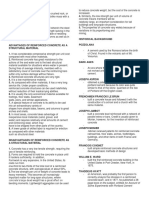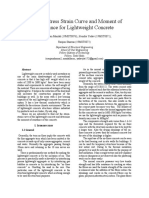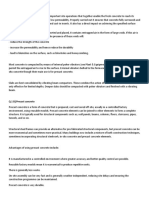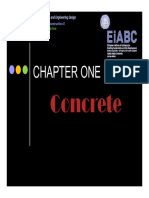JEBS
JEBS
Uploaded by
Balte, Richard F.Copyright:
Available Formats
JEBS
JEBS
Uploaded by
Balte, Richard F.Copyright
Available Formats
Share this document
Did you find this document useful?
Is this content inappropriate?
Copyright:
Available Formats
JEBS
JEBS
Uploaded by
Balte, Richard F.Copyright:
Available Formats
Concrete American Association of State Highway and
Transportation Officials (AASHTO)
- is a mixture of sand, gravel, crushed
rock, or other aggregates held together in a American Railway Engineering Association
rocklike mass with a paste of cement and water (AREA)
(Sometimes one or more admixtures)
Concretes made with normal portland cement
- has a high compressive strength and a require about
very 2 weeks to achieve a sufficient strength to permit
low tensile strength. the removal of forms and the application of
moderate loads.
Reinforced concrete is a combination of concrete Type I— cement is the normal cement used for
and steel wherein the steel reinforcement most construction, but four other types are useful
provides the tensile strength lacking in the for special situations in which high early strength
concrete. or low heat or sulfate resistance is needed:
Type II—A modified cement that has a lower heat
of hydration than does Type I cement
and that can withstand some exposure to sulfate
Advantages of Reinforced Concrete as a attack.
Structural Material Type III—A high-early-strength cement that will
produce in the first 24 hours a concrete
-Reinforced concrete structures are very rigid. with a strength about twice that of Type I cement.
- It is a low-maintenance material. This cement does have a much
higher heat of hydration.
- Economical material available for footings, floor Type IV—A low-heat cement that produces a
slabs, basement walls, piers, and similar concrete which generates heat very slowly.
applications. It is used for very large concrete structures.
Type V—A cement used for concretes that are to
be exposed to high concentrations of
sulfate.
Disadvantages of Reinforced Concrete as a
Structural Material Admixtures - Materials added to concrete during
or before mixing
-Concrete has a very low tensile strength,
requiring the use of tensile reinforcing. Most common types of admixtures:
Air-entraining admixtures, conforming to the
-Forms are required to hold the concrete in place
requirements of ASTM C260 and C618, are used
until it hardens sufficiently. primarily to increase concrete’s resistance to
freezing and thawing and provide better resistance
Concrete and steel reinforcing work together to the deteriorating action of deicing salts.
beautifully in reinforced concrete structures. The
The addition of accelerating admixtures, such as
advantages of each material seem to compensate calcium chloride, to concrete will accelerate its
for the disadvantages of the other. early strength development.
For steel, the coefficient is 0.0000065 per unit
Retarding admixtures are used to slow the setting
length per degree Fahrenheit, while it varies for of the concrete and to retard temperature
concrete from about 0.000004 to 0.000007 increases.
(average value: 0.0000055)
Superplasticizers - admixtures made from organic
American Concrete Institute’s Building Code sulfonates.
Requirements for Structural Concrete (ACI 318-
11).10 This code, which is used primarily for the
design of buildings, is followed for the majority of Waterproofing materials usually are applied to
hardened concrete surfaces, but they may be
the numerical examples given in this text.
added to concrete mixes.
used, the result may be one and a half or even two
The compressive strength of concrete, fc , is times the shrinkage with other aggregates. To
determined by testing to failure 28-day-old 6-in. minimize shrinkage it is desirable to:
diameter by 12-in. concrete cylinders at a
specified rate of loading (4-in. diameter by 8-in. Under sustained compressive loads, concrete will
cylinders were first permitted in the 2008 code in continue to deform for long periods of time. After
lieu of the larger cylinders). the initial deformation occurs, the additional
deformation is called creep, or plastic flow.
In this expression, Ec is the modulus of elasticity Several other items affecting the amount of creep
in psi, are:
• Creep increases with higher temperatures. It is
highest when the concrete is at about 150◦ F to
160◦ F.
• The higher the humidity, the smaller will be the
free pore water that can escape from the
wc is the weight of the concrete in pounds per concrete. Creep is almost twice as large at 50%
cubic foot, and fc is its specified 28-day humidity than at 100% humidity. It is obviously
compressive strength in psi. This is actually a quite difficult to distinguish between shrinkage
secant modulus with the line (whose slope equals and creep.
the modulus) drawn from the origin to a point on
the stress–strain curve corresponding The tensile strength of concrete varies from about
approximately to the stress (0.45fc ) that would 8% to 15% of its compressive strength. A major
occur under the estimated dead and live loads the reason for this small strength is the fact that
structure must support. concrete is filled with fine cracks.
The dynamic modulus of elasticity, which Shear Strength
corresponds to very small instantaneous strains, is It is extremely difficult in laboratory testing to
usually obtained by sonic tests. It is generally 20% obtain pure shear failures unaffected by other
to 40% higher than the static modulus and is stresses. As a result, the tests of concrete shearing
approximately equal to the initial modulus. strengths through the years have yielded values all
referred the way from one-third to four-fifths of the
Poisson’s ratio — is the ratio of this lateral ultimate compressive strengths.
expansion to the longitudinal shortening.
1.12 Aggregates
Its value varies from about : The aggregates used in concrete occupy about
0.11 for the higher-strength concretes three-fourths of the concrete volume. Since they
0.21 for the weaker-grade concretes, are less expensive than the cement, it is desirable
with average values of about 0.16. to use as much of them as possible. Both fine
aggregates (usually sand) and coarse aggregates
(usually gravel or crushed stone) are used. Any
Shrinkage (Hydration of Cement) aggregate that passes a No. 4 sieve (which has
wires spaced 1 4 in. on centers in each direction)
To achieve this desired workability, considerably is said to be fine aggregate. Material of a larger
more water (perhaps twice as much) is used than size is coarse aggregate.
is necessary for the cement and water to react The maximum-size aggregates that can be used in
(called hydration). reinforced concrete are specified in Section 3.3.2
of the ACI Code. These limiting values are as
After the concrete has been cured and begins to
follows: one-fifth of the narrowest dimensions
dry, the extra mixing water that was used begins between the sides of the forms, one-third of the
to work its way out of the concrete to the surface, depth of slabs, or three-quarters of the minimum
where it evaporates. As a result, the concrete clear spacing between reinforcing.
shrinks and cracks.
When certain absorptive slates and sandstone
aggregates are
• ASTM A706: Low-alloy deformed and plain
bars. These bars, which must be marked with the
High-Strength Concretes letter W (for type of steel), are to be used where
Concretes with compression strengths exceeding controlled tensile properties
6000 psi are referred to as high-strength and/or specially controlled chemical composition
concretes. Another name sometimes given to them is required for welding purposes.
is high-performance concretes because they have
other excellent characteristics besides just high • ASTM A996: Deformed rail steel or axle steel
strengths. bars. They must be marked with the letter R (for
type of steel).
Fiber-Reinforced Concretes
In recent years, a great deal of interest has been • When deformed bars are produced to meet both
shown in fiber-reinforced concrete, and today the A615 and A706 specifications, they must be
there is much ongoing research on the subject. marked with both the letters S and W.
The fibers used are made from steel, plastics,
glass, and other materials. Various experiments SI Bar Sizes and Material Strengths
have shown that the addition of such fibers in The metric version of the ACI Code 318M-11
convenient quantities (normally up to about 1% or makes use of the same reinforcing bars used for
2% by volume) to conventional concretes can designs using U.S. customary units. T
appreciably improve their characteristics. 1. The bar sizes used in the metric version of the
code correspond to U.S. sizes #3 through #18
bars. They are numbered 10, 13, 16, 19, 22, 25,
Reinforcing Steel 29, 32, 36, 43, and 57.
The reinforcing used for concrete structures may 2. The steel reinforcing grades, or minimum steel
be in the form of bars or welded wire fabric. yield strengths, referred to in the code are 300,
Reinforcing bars are referred to as plain/smooth or 350, 420, and 520 MPa.
deformed. The deformed bars, which have ribbed 3. The concrete strengths in metric units referred
projections rolled onto their surfaces (patterns to in the code are 17, 21, 24, 28, 35, and 42 MPa.
differing with different manufacturers) to provide
better bonding between the concrete and the steel, Corrosive Environments
are used for almost all applications. Instead of When reinforced concrete is subjected to deicing
rolled-on deformations, deformed wire has salts, seawater, or spray from these substances, it
indentations pressed into it. Plain bars are not used is necessary to provide special corrosion
very often except for wrapping around protection for the reinforcing. The structures
longitudinal bars, primarily in columns. usually involved are bridge decks, parking
garages, wastewater treatment plants, and various
Grades of Reinforcing Steel coastal
Reinforcing bars may be rolled from billet steel, structures. Also, the bond, or sticking of the
axle steel, or rail steel. Only occasionally, concrete to the steel, is reduced. The result of all
however, are they rolled from old train rails or of these factors is a decided reduction in the life of
locomotive axles. These latter steels have been the structure.
cold-worked for many years and are not as ductile
as the billet steels. Identifying Marks on Reinforcing Bars
1. The producing company is identified with a
These steels are available in different grades as letter.
Grade 50, Grade 60, and so on, where Grade 50 2. The bar size number (3 to 18) is given next.
means the steel has a specified yield point of 3. Another letter is shown to identify the type of
50,000 psi, Grade 60 means 60,000 psi, and so on. steel (S for billet, R in addition to a rail sign for
rail steel, A for axle, and W for low alloy).
4. Finally, the grade of the bars is shown either
• ASTM A615: Deformed and plain billet steel with numbers or with continuous lines. A Grade
bars. These bars, which must be marked with the 60 bar has either the number 60 on it or a
letter S (for type of steel), are the most widely continuous longitudinal line in addition to its main
used reinforcing bars in the ribs. A Grade 75 bar will have the number 75 on it
or two continuous lines in addition to the main
ribs.
Selection of Design Loads
One of the most widely used design-load
specifications for buildings is that published by
Dead loads are loads of constant magnitude that the American Society of Civil Engineers (ASCE).
remain in one position. For a reinforced concrete Some other commonly used specifications are:
building, some dead loads are the frames, walls, • For railroad bridges, American Railway
floors, ceilings, stairways, roofs, and plumbing. Engineering Association (AREA).
• For highway bridges, American Association of
Live loads are loads that can change in magnitude State Highway and Transportation Officials
and position. They include occupancy loads, (AASHTO).
warehouse materials, construction loads, overhead • For buildings, the International Building Code
service cranes, equipment operating loads, and (IBC)
many others. In general, they are induced by
gravity. Impact of Computers on Reinforced Concrete
Design
Among the many other types of live loads are: The availability of personal computers has
drastically changed the way in which reinforced
Traffic loads for bridges—Bridges are subjected concrete structures are analyzed and designed. In
to series of concentrated loads of varying nearly every engineering school and office,
magnitude caused by groups of truck or train computers are routinely used to handle structural
wheels. design problems.
Impact loads—Impact loads are caused by the
vibration of moving or movable loads.
Longitudinal loads—Longitudinal loads also need
to be considered in designing some structures.
Miscellaneous loads—Among the other types of
live loads with which the structural designer will
have to contend are soil pressures (such as the
exertion of lateral earth
pressures on walls or upward pressures on
foundations),
Environmental loads are loads caused by the
environment in which the structure is located.
1. Snow and ice. In the colder states, snow and ice
loads are often quite important.
2. Rain. Although snow loads are a more severe
problem than rain loads for the usual roof, the
situation may be reversed for flat roofs—
particularly those in warmer climates.
3. Wind. A survey of engineering literature for the
past 150 years reveals many references to
structural failures caused by wind. Perhaps the
most infamous of these have been bridge failures
such as those of the Tay Bridge in Scotland in
1879 (which caused the deaths of 75 persons) and
the Tacoma Narrows Bridge (Tacoma,
Washington) in 1940.
4. Seismic loads. Many areas of the world are in
earthquake territory, and in those areas, it is
necessary to consider seismic forces in design for
all types of structures.
You might also like
- BR211 Radon Measures For New DwellingsDocument54 pagesBR211 Radon Measures For New DwellingsAndy FrostNo ratings yet
- Concrete Works PresentationDocument50 pagesConcrete Works Presentationsherwin evangelio86% (7)
- 2.case Study Richardson Marcus 2 Compressed - Copy2Document47 pages2.case Study Richardson Marcus 2 Compressed - Copy2marzdesignNo ratings yet
- TBM Vs NATMDocument28 pagesTBM Vs NATMLekhraj Singh100% (2)
- Introduction To Reinforced ConcreteDocument65 pagesIntroduction To Reinforced ConcreteIsmail FarajpourNo ratings yet
- ARAS Chapter 1Document10 pagesARAS Chapter 1patatas e.No ratings yet
- Types of ConcreteDocument6 pagesTypes of ConcreteBe ChahNo ratings yet
- Introduction To RCDDocument41 pagesIntroduction To RCDChristian James Ingco100% (1)
- Introduction To Reinforced ConcreteDocument54 pagesIntroduction To Reinforced ConcreteHussain Al AmerNo ratings yet
- Concret CementDocument29 pagesConcret CementKamal Hameed Al-taiy100% (1)
- Introduction To Reinforced Conrete: Prepared By: Engr. Christopher E. RodolfoDocument35 pagesIntroduction To Reinforced Conrete: Prepared By: Engr. Christopher E. RodolfoKristoff LorenzoNo ratings yet
- What Is The Difference Between Cement and Concrete?Document26 pagesWhat Is The Difference Between Cement and Concrete?Al-Buruj InstituteNo ratings yet
- Topic 1 - Properties of ConcreteDocument13 pagesTopic 1 - Properties of ConcreteDilon FernandoNo ratings yet
- Reinforced Concrete: AI-Gadhib/CE 315/CE 323Document22 pagesReinforced Concrete: AI-Gadhib/CE 315/CE 323Thalia Arias GuevaraNo ratings yet
- Types of Concrete and Its ApplicationDocument8 pagesTypes of Concrete and Its ApplicationErmiyas AlhegnNo ratings yet
- RCDDocument3 pagesRCDJesselle CelestialNo ratings yet
- Reinforced Concrete IntroductionDocument46 pagesReinforced Concrete IntroductionJohn Cedrick JulatonNo ratings yet
- Week 4 - Materials Used in PrestressDocument121 pagesWeek 4 - Materials Used in PrestressTris CollectionNo ratings yet
- Effect of Admixture On Properties of ConDocument12 pagesEffect of Admixture On Properties of ConTahmidtuhinNo ratings yet
- Villanueva Assignment1 PRCDocument5 pagesVillanueva Assignment1 PRCARC VILLANUEVANo ratings yet
- Assigment 1 For BSCDocument16 pagesAssigment 1 For BSCSaddam Abdulrahman AlazzaniNo ratings yet
- Final BodyDocument63 pagesFinal BodyAbubakar MusaNo ratings yet
- University of Engineering and Technology LHR, (NWL Campus) Lab Manual Subject: Plain Reinforcement ConcreteDocument57 pagesUniversity of Engineering and Technology LHR, (NWL Campus) Lab Manual Subject: Plain Reinforcement ConcreteNoman AliNo ratings yet
- ConcreteDocument43 pagesConcreteshafeeq KoottayiNo ratings yet
- RC Notes by Engr. GREGDocument49 pagesRC Notes by Engr. GREGMichael SuanNo ratings yet
- Study of Stress Strain Curve and Moment of Resisitance For Lightweight ConcreteDocument6 pagesStudy of Stress Strain Curve and Moment of Resisitance For Lightweight ConcreteJitendra YadavNo ratings yet
- Dcs 1Document12 pagesDcs 1Sai PrintersNo ratings yet
- Chapter 1. Introduction To ConcreteDocument9 pagesChapter 1. Introduction To ConcreteKhaled Al-SwairkiNo ratings yet
- Concrete 078bce025Document11 pagesConcrete 078bce025078bce025.anirudraNo ratings yet
- Chapter-1: Department of Civil Engg, CBITDocument26 pagesChapter-1: Department of Civil Engg, CBITShashidhara TVNo ratings yet
- Special Concrete and Concreting TechniquesDocument47 pagesSpecial Concrete and Concreting TechniquesTesfayeNo ratings yet
- ConcreteDocument9 pagesConcreteMahawa KabbaNo ratings yet
- Methodology & Materials For Prestressed Concrete: Aashish Kumar, Aman MalikDocument3 pagesMethodology & Materials For Prestressed Concrete: Aashish Kumar, Aman MalikerpublicationNo ratings yet
- Lecture 1-Introduction EditDocument38 pagesLecture 1-Introduction Editaduyekirkosu1scribdNo ratings yet
- LEC01 - Reinforced Concrete Design Introduction V02Document51 pagesLEC01 - Reinforced Concrete Design Introduction V02Migs David100% (1)
- Act Module 5Document142 pagesAct Module 5Bony MathewNo ratings yet
- Reinforced Concrete Structure I: References: Design of Reinforced Concrete (Jack C. Mccormac)Document45 pagesReinforced Concrete Structure I: References: Design of Reinforced Concrete (Jack C. Mccormac)Alam MaulanaNo ratings yet
- Ferro CementDocument27 pagesFerro Cementasad burleegNo ratings yet
- Ferro CementDocument23 pagesFerro Cementasad burleeg100% (1)
- TOS Theory AnswersDocument6 pagesTOS Theory AnswersRizzel DiasNo ratings yet
- Construction Masterials, Construction Methods, Project ManagementDocument4 pagesConstruction Masterials, Construction Methods, Project ManagementMary Joy AzonNo ratings yet
- Chapter 1 Introduction To Reinforced Int PDFDocument53 pagesChapter 1 Introduction To Reinforced Int PDFAl Joshua ApuraNo ratings yet
- Week 6 ConcreteDocument26 pagesWeek 6 Concreteisrarisroo10No ratings yet
- Construction Materials and Testing Chapter 4Document17 pagesConstruction Materials and Testing Chapter 4EFREN REYES IINo ratings yet
- Concreting Underwater - Compressed PDFDocument15 pagesConcreting Underwater - Compressed PDFIndigo CupcakeNo ratings yet
- Admixtures: Beam Is A Structural Element That Primarily Resists Loads Applied Laterally To TheDocument6 pagesAdmixtures: Beam Is A Structural Element That Primarily Resists Loads Applied Laterally To TheMaster PogiNo ratings yet
- 6-Concrete Construction (CH.15)Document49 pages6-Concrete Construction (CH.15)Zynb AlhlalNo ratings yet
- Reinforced ConcreteDocument57 pagesReinforced ConcreteBeatriz LasherasNo ratings yet
- Lab Manual Prc-1Document84 pagesLab Manual Prc-1HAFIZ ARSALAN ALI50% (2)
- Concete TechnologyDocument24 pagesConcete Technologyአዲስ አዲስNo ratings yet
- HIGH DENSITY ConcreteDocument9 pagesHIGH DENSITY ConcreteVishnupriya B.No ratings yet
- Advantages of Prestressed ConcreteDocument9 pagesAdvantages of Prestressed ConcreteKuruNo ratings yet
- RCD PLATE1 IntoductionDocument6 pagesRCD PLATE1 IntoductionEugene TongolNo ratings yet
- Reinforced Concrete Design :introductionDocument52 pagesReinforced Concrete Design :introductionRandy PolicarpioNo ratings yet
- Question No .1 Heat of HydrationDocument11 pagesQuestion No .1 Heat of Hydrationishtiaq raoNo ratings yet
- MaterialDocument80 pagesMaterialNaol AdugnaNo ratings yet
- PRC 1 Lab ManualDocument67 pagesPRC 1 Lab ManualzainjoiyaNo ratings yet
- Concrete Basics PDFDocument30 pagesConcrete Basics PDFDarshan Rokztar100% (1)
- Chapter 7 - Special ConcretesDocument67 pagesChapter 7 - Special Concreteseyob yohannesNo ratings yet
- Concrete Mix DesignDocument3 pagesConcrete Mix Designashok daukiyaNo ratings yet
- Literature Summaries Act 11Document15 pagesLiterature Summaries Act 11Balte, Richard F.No ratings yet
- New Last 1Document1 pageNew Last 1Balte, Richard F.No ratings yet
- Script HighwayDocument6 pagesScript HighwayBalte, Richard F.No ratings yet
- Enu IDocument5 pagesEnu IBalte, Richard F.No ratings yet
- Engr. Ramon A. Orbita Engineering Utilities 2 Trajano, FrancisDocument1 pageEngr. Ramon A. Orbita Engineering Utilities 2 Trajano, FrancisBalte, Richard F.No ratings yet
- A B D E F C G A B D E F C G: Engr. Ramon A. Orbita Engineering Utilities 2 Trajano, FrancisDocument1 pageA B D E F C G A B D E F C G: Engr. Ramon A. Orbita Engineering Utilities 2 Trajano, FrancisBalte, Richard F.No ratings yet
- Engr. Ramon A. Orbita Engineering Utilities 2 Tan, Maria Francheska ZDocument1 pageEngr. Ramon A. Orbita Engineering Utilities 2 Tan, Maria Francheska ZBalte, Richard F.No ratings yet
- Em Reviewer Q2Document2 pagesEm Reviewer Q2Balte, Richard F.No ratings yet
- Enmath 5 Project Balte Macapundag TanDocument12 pagesEnmath 5 Project Balte Macapundag TanBalte, Richard F.No ratings yet
- G2 Bayesian AnalysisDocument4 pagesG2 Bayesian AnalysisBalte, Richard F.No ratings yet
- Group 2 - em (Bayesian Analysis)Document4 pagesGroup 2 - em (Bayesian Analysis)Balte, Richard F.No ratings yet
- Report ChemDocument5 pagesReport ChemBalte, Richard F.No ratings yet
- Transformation ProcessDocument1 pageTransformation ProcessBalte, Richard F.No ratings yet
- STS - Activity 1-Reflection TaskDocument3 pagesSTS - Activity 1-Reflection TaskBalte, Richard F.No ratings yet
- CONTEMP ReviewerDocument3 pagesCONTEMP ReviewerBalte, Richard F.No ratings yet
- R1 Cheruthony Truss 4 - 4Document1 pageR1 Cheruthony Truss 4 - 4Anujith K BabuNo ratings yet
- Classification of HandtoolsDocument64 pagesClassification of HandtoolsVergil MontemayorNo ratings yet
- EB 01 For 1st Level CharactersDocument18 pagesEB 01 For 1st Level Charactersmichele pendriagoNo ratings yet
- Fitsum Final Report 1Document47 pagesFitsum Final Report 1ermias asalifNo ratings yet
- Xstructures Xstructures Engineering Engineering Consultants Consultants Engr. Engr. John John Paul Paul Dela Dela Rosa RosaDocument150 pagesXstructures Xstructures Engineering Engineering Consultants Consultants Engr. Engr. John John Paul Paul Dela Dela Rosa RosaKurtuNo ratings yet
- Asuc Underpinning and Mini Piling Guidelines 2015Document98 pagesAsuc Underpinning and Mini Piling Guidelines 2015Xe CohNo ratings yet
- Building Shell Spec 5-10-21Document13 pagesBuilding Shell Spec 5-10-21andres gonzalesNo ratings yet
- Floor Ceiling ChecklistDocument3 pagesFloor Ceiling ChecklistdanoNo ratings yet
- Athul 5Document29 pagesAthul 5Baseem FajilNo ratings yet
- RevitKeynotes NZLDocument50 pagesRevitKeynotes NZLPranshu LondaseNo ratings yet
- Spesifikasi Tehnik Lift Menara PandangDocument6 pagesSpesifikasi Tehnik Lift Menara PandangNasrullah STNo ratings yet
- Materials Affect The Way Art Is Made?, Jed?Document7 pagesMaterials Affect The Way Art Is Made?, Jed?yoursytuly100% (1)
- Lecture 2 - Influence of Design Variables On CostDocument3 pagesLecture 2 - Influence of Design Variables On Costkasiva cindyNo ratings yet
- Ngozi Primary School BoqsDocument30 pagesNgozi Primary School BoqsChobwe Stephano KanyinjiNo ratings yet
- Quantity Surveying - Electrical WorksDocument57 pagesQuantity Surveying - Electrical WorksBilly Joe GodoyNo ratings yet
- Tariku Case Study Research On Residential BuildingDocument33 pagesTariku Case Study Research On Residential BuildingRobel ZerihunNo ratings yet
- 05.16.2022SOW&Gen - Specs.SGP RDP AdminBldg.Document8 pages05.16.2022SOW&Gen - Specs.SGP RDP AdminBldg.Mohammed AzharNo ratings yet
- Paper MacheDocument24 pagesPaper MacheKrishna PatelNo ratings yet
- Foundation Design 35-210-H1Document11 pagesFoundation Design 35-210-H1shahed.gpiasiatelNo ratings yet
- TAS 201-94 - Impact Test ProceduresDocument7 pagesTAS 201-94 - Impact Test ProceduresAndrea Nicola TurcatoNo ratings yet
- Paper Model - Microtactix - Vyllage On The Cheep Castle RuinsDocument16 pagesPaper Model - Microtactix - Vyllage On The Cheep Castle RuinsOlivi CrimacoNo ratings yet
- Plan Standard Plan For PCCP 0.280 M Thick and 6.7 M Wide: General NotesDocument1 pagePlan Standard Plan For PCCP 0.280 M Thick and 6.7 M Wide: General NotesMarl John PinedaNo ratings yet
- TOA 213 - Midterm ExamDocument5 pagesTOA 213 - Midterm ExamJoenard CastroNo ratings yet
- Adelina's Whales - IIDocument4 pagesAdelina's Whales - IIMaya AymanNo ratings yet
- Description Packaging Shelf Life CoverageDocument2 pagesDescription Packaging Shelf Life Coveragejet toledoNo ratings yet
- Brigada Eskwela Form 4 Daily Attendance of VolunteerDocument2 pagesBrigada Eskwela Form 4 Daily Attendance of VolunteerTine RanuloNo ratings yet







































































































